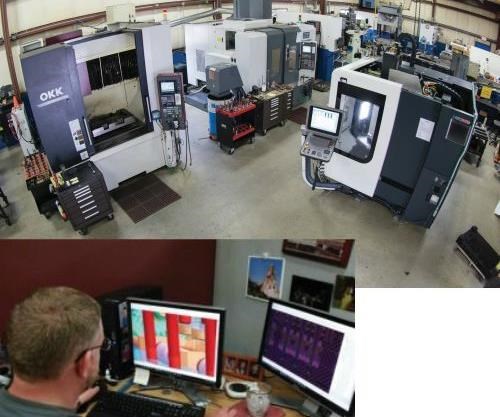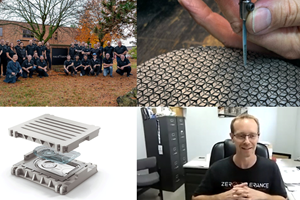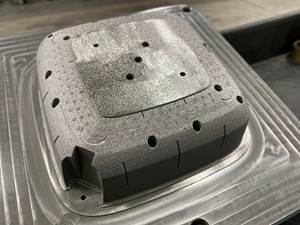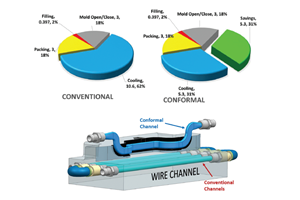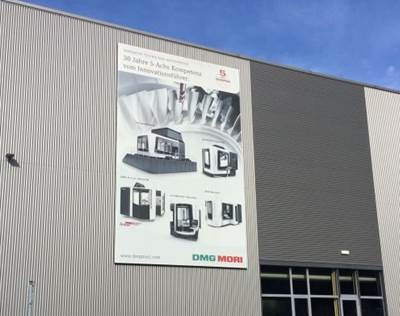IIoT: The Next Step in Mold-Building Efficiency
Taking advantage of “digital threads” of data can help moldmakers compete in an evolving manufacturing environment.
The Industrial Internet of Things (IIoT), also known as Industry 4.0, digital manufacturing and any number of other monikers depending on where you’re standing at the moment, is not exactly new, but it is still somewhat of a mystery. For those willing to embrace it, there is no doubt that it will profoundly impact manufacturing operations around the world. But what exactly is it? How will it impact mold manufacturers as part of the supply chain?
In its most basic form, the IIoT is data-driven manufacturing. It involves consistent, accurate capture and analysis of “big data,” collected through the use of sensors and monitors, to make more informed decisions on the factory floor. Through high-level digital connectivity, it represents an opportunity to advance supply chain efficiencies and traceability, while also advancing quality control, and sustainable and green practices.
Victor Baez, an advanced manufacturing engineering executive at GE Energy Connections, Industrial Solutions, and a current member of this magazine’s Editorial Advisory Board, is heavily engaged with mold builders and molders in the manufacture of molded case circuit breakers (MCCBs) and other related products. Baez says GE is “all in” on the IIoT and expects its supply chain to adapt to it as well.
Baez’s team is responsible for developing advanced manufacturing technology and supporting new product introductions. This includes supporting product design for manufacturing and assembly, as well as launching into GE’s manufacturing plants, working with the supply chain and customers. Ultimately, he says, everyone wants to simplify this process, and utilizing data concurrently to progress through many analytical loops in order to track performance is key. This is where the IIoT comes into play, and despite the fact that buy-in by the mold industry and other points in the supply chain is slow, the growth of the IIoT is fast. Playing catchup is not a smart strategy, Baez says.
“This is going to be a faster evolution than when we all switched from two-axis to three-axis machine technology to five-axis,” he says. “That was very capital-intensive, costing businesses a lot of money on equipment to get into or stay in the game. Nobody today is completely engaging the IIoT as an end-to-end solution yet, but they are using pieces of it here and there as technology becomes available. The question is, do you understand where it’s going and how to connect with it? Are you going to drive it, or will you be first to be second and chase it?”
Prior to joining GE, Baez worked for Rockwell Automation, a manufacturer of control products and solutions, where he led new product launches in advanced manufacturing engineering plastics technology. He also worked for five years at Triangle Tool Corp. as an engineering sales manager, and prior to that was with MGS Mfg Group for 12 years as vice president of program management. Additionally, he is a registered journeyman toolmaker. All of this experience, in addition to his current involvement with the IIoT at GE, has motivated him to want to help educate moldmakers on its value.
Baez asserts that the IIoT presents an opportunity for any mold manufacturer who chooses to embrace it. Small shops can compete with large ones so long as 1) they are using CAD software with the ability to use critical information such as dimensions and functional tolerancing, and annotations; 2) that information can be easily exchanged with the customer in a paperless environment; 3) the shops have high-speed Internet; and 4) they have an engineering mindset and are willing to embrace the next wave of change.
Digital Thread and Model-Based Engineering
“When you look at the IIoT, there are numerous interpretations, and I’d be leery of anyone who says he’s an expert on it,” Baez says. “But its effect on mold manufacturing and the supply chain is real, and it’s imminent. Leaders in moldmaking need to be engaged, and the digital thread, as well as model-based engineering, are key aspects for them to understand.”
The National Institute of Standards and Technology (NIST) describes “digital thread” this way: “Information ‘silos’ for various life cycle processes are slowly being connected to form a ‘digital thread’ of information that is envisioned to integrate and drive modern design, manufacturing and product support processes.” But according to NIST, today’s digital thread is filled with gaps that impede the flow of information from design to manufacturing and assembly to inspection. NIST is currently working to develop methods and protocols that will complete the digital thread and fully integrate modern design, manufacturing and product support processes within the IIoT framework.
Baez believes that the digital thread is a key part of the IIoT equation. “By definition, digital eliminates paper,” he says. “Mold-makers, as well as manufacturing plants, need to embrace the fact that they will not have something to actually hold. All product information will be digitally part of 3D CAD models. Moldmakers will be taking this information and making full 3D CAD tool designs and then creating the machining language (CAM).”
The focus here, he says, is on data exchange. “Moldmakers are not used to pulling tolerances and critical-to-quality (CTQ) data from a model. They typically use 2D prints. With the IIoT, prints will be obsolete.”
Another key component of the IIoT is model-based design and engineering. According to NIST, this is an approach to product development, manufacturing and lifecycle support that uses a single, digital 3D model and all required product data within a securely managed environment to drive all engineering activities within the digital thread.
“This is where the leaders in the moldmaking industry can make their power play,” Baez says. “They need to own the model-based engineering side of IIoT. For instance, from concept to part, a plastic part may change five or six times through various iterations based on assembly requirements or product design requirements. All of the data for the part changes must be contained
and annotated within one 3D model, so that it can be understood and reused by downstream users and computer applications.”
GE incorporates the digital thread and model-based engineering aspects of IIoT with its FastWorks approach: Design as you go, based on customer needs and feedback. For example, a design team will work on a project with the goal of producing a minimally viable product (MVP), using both traditional and non-traditional technologies, such as additive manufacturing. Much of the process is done in house, but suppliers must be able to manage the pace of iteration with the designers to avoid falling behind. “Toolmakers have to be flexible with their mold design intent,” Baez says. “They have to leave the design flexible and concurrently begin roughing out mold bases, cores, cavities, etc., while still being ready for the next part iteration without losing momentum.”
The FastWorks approach requires that everyone in the supply chain work off the same model-based engineering design, thus creating a network of digital threads that spider off the model, including assembly fixtures and anything else that goes into manufacturing a product. Each thread depends on the model design and must be integrated at the same pace as the tool design and build. If design changes occur, everyone involved is notified in real time.
Baez says this “design flexibility” concept will be the hardest change for moldmakers to grasp and embrace. “Instead of starting mold design and build when a customer has fully designed a part model, they will need to play a larger role in the product development process, designing molds concurrently with product design teams in order to more efficiently incorporate part iterations,” he says. “This means identifying constraints upfront, and designing the molds so that they can be easily modified until part design is complete and parts are in production.”
With its growing application within moldmaking, additive manufacturing also has a role to play in the IIoT. This technology can save considerable time in the overall production process, as concepts and design iterations can be proven and incorporated in a reduced timeframe. Instead of scrapping out a cavity or core insert because of a part-feature change, for example, moldmakers can use additive technologies to incorporate changes, Baez says. In the future, he also expects that additive increasingly will be used to develop modular tools that can be easily designed and into which changes can be easily integrated.
The IIoT will continue to unfold and define itself for moldmakers and their customers. The good news is that it’s anybody’s game in the sense that the size of a shop is not a factor in its ability to join this fast-advancing trend. Understanding how the IIoT works and focusing on design flexibility, working concurrently with other key players in the digital thread, and using model-based engineering to expedite the entire manufacturing process will be vital for those looking to lead in this arena.
Related Content
Large Hybrid Steel Insert Solves Deformation, Dimensionality, Cycle Time Problems
DMLS printers using metal additive powders selected by Linear AMS to produce high-quality, accurate, consistent 3D-printed mold components with certification and traceability.
Read More4 Keys to a Successful Mold-Building Operation, The Latest Mold Design Tips & More
MoldMaking Technology is off to a strong start this year with mold design tips, key considerations for running a mold-building “business,” polishing pointers for ribs and more. Check out our list of top-viewed articles from January and see what catches your eye.
Read MoreA 3D Printing Retrospective
A personal review of the evolution of 3D printing in moldmaking throughout the past 25 years.
Read MoreHow to Use Thermal Management to Improve Mold Cooling
A review of common mold cooling issues and possible solutions, including 3D printing applications.
Read MoreRead Next
Breakthroughs and Possibilities
Okuma’s annual Technology Showcase highlighted the latest innovations in manufacturing technology.
Read MoreA Focus on Technology, Not Just Machines
Beneath the sun and mountains of Pfronten, Germany, sits a 79,000 square-foot facility focused on technology, not just machines. And last week it was the site for DMG MORI’s annual Open House where 88 high-tech machines, six world premieres and an industry outlook were presented to visitors from around the globe, including me. Here I want to share a few of the highlights that just may be of interest to you.
Read More

